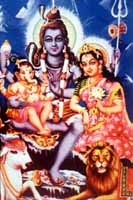 Shiva
and Durga with Ganesha Shiva and Durga with Ganesha
Shiva
and Durga with Ganesha Shiva and Durga with Ganesha
In this painting Shiva is with Durga. Durga is on the lion. Although the Goddess Durga is shown here with Shiva she is also worshipped in her own as the Great Goddess
The Goddess (Shakti)
The consort of the great god Shiva, "Devi" or "Mahadevi" Great Goddess is the most many-sided, many-shaped and intricate of the dieties.
She has many names, many personalities, and is not only the central figure of a number of myths but also the main figure of worship for about 50 million Hindus who worship some form of the goddess.
From ancient times worship of the divine female has been associated with worship of nature, especially trees and rivers.
On the same level of worship as the Supreme Triad (Brahma, Vishnu, Shiva) stand the female deity, or the female expression of the Divine.
She is worshipped as Parvati, or as Durga or as Uma or as Kali.
She is also called Mata or Mother, meaning Mother India. She is associated with fertility and the earth.
She can be represented as the yoni, the female principle that surrounds the male linga.
The power of a devi or a goddess is shakti. This Shakti is the activating energy. The female possesses this dynamic element or activating energy. The female is the creative force.
To understand the idea of Shakti and the part that this concept plays in Hinduism, one should start from its fundamental idea of universal unity, which involves both a continuous division into pairs of opposites in conflict with each other and then a continuous merger of them into a harmonious synthesis. The male aspect of Divinity is endowed with passivity and undisturbed serenity. The female aspect (Shakti) possesses the dynamic element or activating energy, the dynamism of time. Apparently opposing each other, these two elements or aspects of the Divine are one in substance.
Parvati and Uma are the beniegn aspects of the goddess as well as the destroyer goddesses Kali and Durga are in turn all aspects of the Devi, or the Great Goddess. The land of India is said to be the body of the Goddess and she is thus approachable to her devotees.
